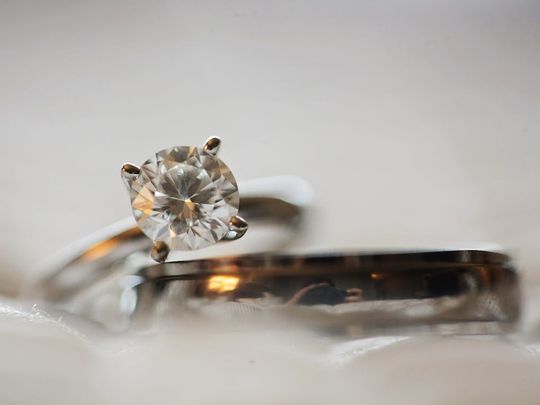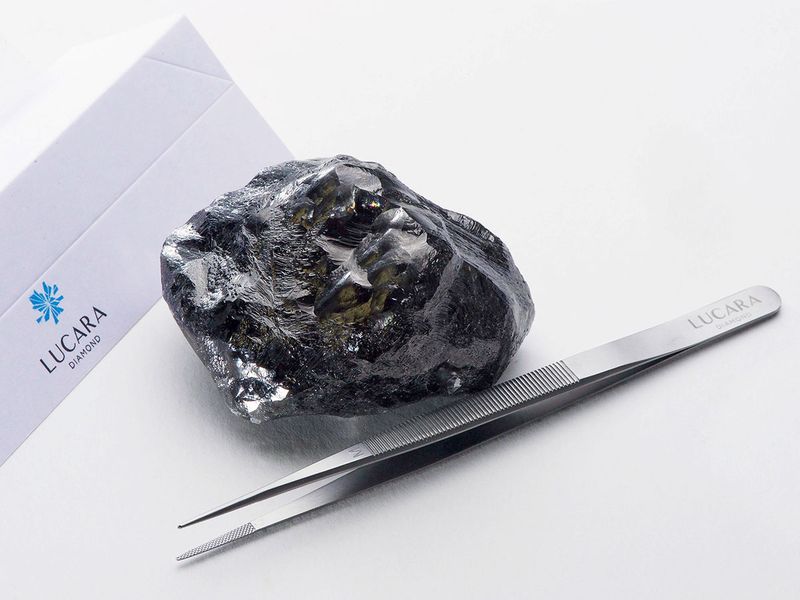
Dubai: It’s brilliant, it’s rare and it’s become a symbol of true love. But it may have been created in a few weeks’ time at a laboratory instead of over millions of years under the earth’s surface.
Lab-grown diamonds are now an alternative to natural, mined diamonds, making their presence felt in the precious stones market. They have come a long way since 1954, when the first synthetic diamond was created in a General Electrics (GE) laboratory in the US. Up until two years ago, the market size of lab-grown diamonds – also referred to as Chemical Vapour Deposition (CVD) diamonds – was $400 million, according to a report by Business Research Insights, a research organisation based in India. The same report estimated the CVD diamonds business to touch $676.4 million by 2028. They are also picking up in the UAE market, as reported by Gulf News, with younger customers more inclined to purchase a synthetic diamond.
But what exactly are synthetic or lab-grown diamonds? And how different are they from natural ones? Let’s find out.
How are natural diamonds formed? A brief history

Even before diamond rings became synonymous with proposals, diamonds were highly valued gems in most societies.
When writing his natural history encyclopedia in the first century AD, Roman scholar Pliny the Elder described them as “the most valuable, not only of precious stones, but of all things in this world.”
The natural process through which diamonds are formed is also fascinating – forged over millions if not billions of years under immense heat and pressure miles deep under the earth. They are then pushed closer to the surface through tectonic shifts or volcanic eruptions. Once found, these rough diamonds have to be chiseled out to form the brilliant stones that you see at a store’s display.
According to the Gemological Institute of America (GIA), which established the 4 Cs standard for evaluating diamond quality (cut, clarity, colour and carat weight), the world’s love of diamonds had its start in India, where diamonds were gathered from the country’s rivers and streams. “Some historians estimate that India was trading in diamonds as early as the fourth century BC,” the GIA website states.
But since then, the diamond trade has expanded exponentially, with diamond mines discovered in countries like South Africa, Democratic Republic of Congo, Botswana, Russia, Australia and Canada.
But … what’s love got to do with it?

While diamonds were always historically associated with affluence, it was an ad campaign that created the enduring connection the stones have with love. One of the most iconic ad slogans of the 20th century – ‘A diamond is forever’ – was created in 1948 by the diamond company De Beers. With it, was created the tradition of using a diamond ring as a mark of your love, when popping the question, “Will you marry me?”
Commenting on how this marketing campaign created a global behavioural change, the website of Campaign Asia, an online magazine specialising in media and marketing analysis, stated: “These days, most people think [proposing with a diamond ring] is an age-old tradition dating back centuries, when in fact it’s the result of one of the most brilliant ad campaigns in history. Your love is permanent? Then prove it with something that’s equally indestructible.”
The diamond’s image was further burnished when Marilyn Monroe sang ‘Diamonds Are a Girl’s Best Friend’, in the 1953 film ‘Gentlemen prefer blondes’, something that De Beers was again closely involved with. Finally, what can be considered a home run for this massive campaign, De Beers also went ahead and put a very specific amount to how much a man should spend on his fiancé’s engagement ring, suggesting men should spend a month’s salary on a ring. This was then pushed to two months’ salary, following the campaign’s success.
In 1977 De Beers ad film, a narrator is heard saying: “How else could two months’ salary last forever?” as a man proposes to a woman on the beach, with what looks like a dream home in the background.
All these messages came together to make diamond rings specifically, and diamonds in general, symbolic of true love, an idea that got deeply engrained in people’s minds.
How lab-grown diamonds are changing the market
Around the same time as this iconic campaign was shifting the perceived value value of a diamond, scientists across the world were busy at work – creating a controlled environment that could mimic the natural processes atoms of carbon undergo to turn into these sought-after gems.
While the experiment by the team of scientists at GE’s labs created the first ever lab-grown diamonds in the 1950s, it took decades for researchers and scientists across the globe to produce the diamonds that are now found in most markets in the world.
While the original process that was followed to create lab-grown diamonds was a ‘high-pressure high-temperature’ (HPHT) method, today, lab-grown diamonds are synthesised using a process called Chemical Vapour Deposition (CVD), where carbon gas heats a diamond ‘seed’ – a tiny, single crystal of diamond – in a chamber, or oven if you like. The heat converts carbon gas into a plasma of carbon, which sticks to the seed, allowing it to grow into a larger diamond.
But how different are these synthetic diamonds to natural ones? Not at all, says gemologist David Weinstein. Speaking to US-based magazine Insider in 2017, he said: “Diamonds have a definition. They have a certain hardness. They have a certain chemical structure. They have a certain chemical composition. In that respect, laboratory-grown diamonds are really the same as mined diamonds.”
Diamonds have a definition. They have a certain hardness. They have a certain chemical structure. They have a certain chemical composition. In that respect, laboratory-grown diamonds are really the same as mined diamonds.
A greener alternative?
What does differ, though, is the environmental impact each process has. Mining for diamonds can permanently damage the surrounding environments. The drilling of open pits and tunnels to mine for diamonds destroys the natural landscape irrevocable. The mining process itself can cause soil, air and water pollution. Miners also face health risks, working in hazardous conditions.
While these concerns have been addressed to some extent by diamond mining companies, “accidents and violations of regulations still happen”, according to the largest online gemology resource and community – International Gem Society.
Lab-grown diamonds offer a more sustainable – and oftentimes cheaper – alternative.
Most lab-grown diamond companies state that they use renewable energy resources, partially if not fully, to create the stones. A 2014 environmental impact analysis of the production of rough diamonds by US-based business consultant Frost and Sullivan found that mining diamonds produces 4,383 times more waste than manufactured gems, uses 6.8 times as much water, and consumes 2.14 times the energy per carat produced. These numbers were shared by earth911.com, one of the largest online recycling databases in the world.
Lab-grown diamonds are also usually cheaper than mined ones. Depending on the type of diamond, you may pay anywhere from 30 to 50 per cent, or even less for a synthetic diamond.
But are these reasons enough to sway consumers from the allure of a natural diamond?
Caters to Gen Z’s shift towards ethical lifestyle
Readers who spoke with Gulf News appeared to be divided over their love for lab-grown diamonds – while some felt that synthetic diamonds were a better alternative, given the sustainability and ethics of the process, for others true diamonds would always be natural.
Anjali Khushalani, a 39-year-old Dubai resident who works in the fashion and event management industry, spoke about people’s shift towards more sustainable living and how lab-grown diamonds fit perfectly into this lifestyle choice.
“The younger generation is more open to this kind of a concept. While there are still people who are very traditional and have a sentimental attachment to diamonds, there are also people who are moving to more sustainable options, whether it is clothing or diamonds. It is affordable as well. Post Covid-19, people’s mindset has changed - they are looking at more affordable options and looking to save the environment, too.”
The younger generation is more open to this kind of a concept. While there are still people who are very traditional and have a sentimental attachment to diamonds, there are also people who are moving to more sustainable options, whether it is clothing or diamonds.
While she hasn’t bought a lab-grown diamond yet, she said that she would be more than happy to opt for it over mined diamonds.
Another Gulf News reader, Canadian expat Sarita Kolhatkar, also said that she was open to buying lab-grown diamonds as they are more ethical and sustainable.
The 39-year-old art director said: “We as a society are trying to work towards better health for the environment. There is a lot of history [with mined diamonds] when it comes to blood diamonds or the abuse of workers and child labour and funding wars in a lot of places, not to mention deforestation, soil erosion and the complete depletion of resources. We are at a place right now where we should be worrying about the planet, because our children are not going to have the same planet that we grew up in. If you can have an ethical and affordable option, why won’t you choose it?”
If you can have an ethical and affordable option, why won’t you choose it?
But not everyone seems to be on board the lab-grown diamonds train. Some readers who belong to the Millennial generation or Generation Z also shared their reservations with shifting more natural diamonds to synthetic ones.
“I do see value in buying a lab diamond because it is definitely cheaper, but just for me as a consumer, diamond is luxurious. When I wear it I want people to know that it is a natural diamond and if I can’t afford one, then I just won’t buy it, instead of getting a replica to give the impression that I have a real one. It is just a matter of preference,” Mashaal Amir, a 29-year-old Pakistani tax manager living in Dubai said.
If I can’t afford one, then I just won’t buy it, instead of getting a replica to give the impression that I have a real one.
Another Dubai resident, 28-year-old business development professional Raya Khalid, echoed the sentiment.
“I do know about lab-grown diamonds but I am not willing to buy them because at the end of the day, a diamond is made after it is gone through a natural process. We are paying for the mining, the effort it takes for the diamond to form and the actual thing that is from Nature. Lab-grown diamonds, to me, do not make any sense. At the end of the day, it is not about how much I am paying but what I am buying. I am not going to be lying to myself or convincing myself that I am wearing a natural diamond when it is man-made,” the Iraqi expatriate said.

At the end of the day, a diamond is made after it is gone through a natural process.
37-year-old company owner Rosa Bullock also said that while she was familiar with the concept of synthetic diamonds, it would not be something she would consider buying “mainly because of the authenticity of it.”
“The diamonds I own aren’t lab-grown. It is a bit like handbags – if I can’t afford it, I won’t buy it,” the British expatriate added.
It is a bit like handbags – if I can’t afford it, I won’t buy it.











